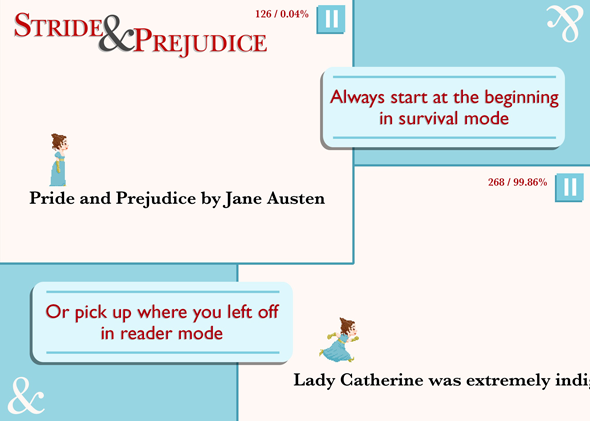Over the weekend, I broke a personal rule of mine: never quitting a book before finishing it. The novel I deserted was none other than the beloved Pride and Prejudice. But before you choke yourselves with your chokers, know that I gave up on my first attempt at reading this novel not because I liked it too little, but because I liked it too much.
The fault, you see, lay not in the book, but its method of delivery: It was presented by a new video game, Stride & Prejudice, which is “an endless runner based on Pride and Prejudice by Jane Austen,” per its tagline. This isn’t your usual “based on” video game adaptation of literature, like the 2010 hack-n-slash inspired by Dante’s Inferno, or Slate’s own interactive version of The Great Gatsby. In Stride & Prejudice, the book is the game, its words forming a steady succession of platforms that your character, Elizabeth Bennet, runs and jumps across. It’s a 2-D sidescroller, like Mario, except you don’t have to worry about moving the character forward. Elizabeth runs on her own, so your only task is to tap the screen to jump the gaps between the strings of text rushing your way.
Stride & Prejudice offers two ways to play. Survival mode works like a typical endless runner game—that is, the goal is to see how far you can get in the book before Elizabeth falls. Survival mode is meant to be played over and over, with the challenge of beating your high score, and has the ancillary effect of drilling the book’s earliest passages into your head, including its famous opening line:
It is a truth universally acknowledged,
[tap the screen, Ryan!]
that a single man in possession
[tap now!]
of a good fortune,
[augh, jump!]
must be in want of a wife.
What keeps Stride & Prejudice from being just an, ahem, novel take on the endless runner, though, is Reader mode, in which you can “die” infinite times and Elizabeth will reincarnate where she left off. In effect, it’s the book, except with auto-scrolling text and the constant requirement to jump. At 99 cents, Stride & Prejudice is the same price as the Kindle edition of Austen’s novel, except the game saves you from the bother of having to move your eyes to where the words are—what a hassle!—and moves the words move to where you’re looking. Now, it’s easy to give in to the kind of predictable tut-tutting of society that Stride & Prejudice invites at first glance. Two hundred years after this great novel was published, this is the state of pop culture? Have our minds been so fractured by multitasking that we get bored by entertainments that don’t give us “something to do” while we’re being entertained? But my main reaction to Stride & Prejudice is simply: This isn’t a game.
Tapping the screen while “playing” Stride & Prejudice becomes as unconscious a process as turning a page, or hell, holding your iPhone, almost immediately. Indeed, the true downside of consuming Pride and Prejudice in this manner isn’t that you’re too distracted playing the game to read the book—it’s having to read at a pace other than your own. You can adjust how quickly the words scroll, but no one reads at a steady, constant speed.
The benefit, I suppose, of reading at the speed at which you can read, rather than the speed at which you would, is that you cover a lot of ground. After just a couple of hours, I had made it 37.96 percent through the novel. As Mr. Darcy tells Elizabeth, when she asks him exactly when he began to have feelings for her, “I was in the middle before I knew that I had begun.”
The immediate cost of this information injection is an intense visual hangover. You get so inured to the constant flow of text that your vision continues to swim horizontally for several minutes after you stop playing the game. The longer-term cost is a lack of control over your reading experience, and an attendant reduction in retention. If you’re reading great books just to check them off your list, Stride & Prejudice might be the first entry of your favorite new video game series. On the other hand, if that describes you, I can’t help but affect the snobbery of a true Janeite—like, someone who’s actually completed one of her books—and respond to you the way Elizabeth responded to one of Mr. Darcy’s early attempts at conversation:
“What think you of books?” said he, smiling.
“Books — Oh! no. — I am sure we never read the same, or not with the same feelings.”
I asked Carla Engelbrecht Fisher, who created Stride & Prejudice (and who has written for Slate), what she made it for. Is she trying to encourage people to read classics? “I’m honestly divided on making other books into endless runners,” she emailed me. “I’ve joked that we could easily do Anna Ka-running-na or Frank-run-stein, but those texts are dense,” whereas Pride and Prejudice is simple enough to be understood in stock-ticker form.”
So is it a game or a book? “I see it as a gate-way app for both book-lovers and gamers,” she wrote. “Gamers who would never think to read Jane Austen have told me they’re now reading the book, some entirely within the game.” Some. But not me. Fisher accomplished her mission, in that I plan to see where/whom Elizabeth runs to at the end of her not-endless journey (and I have a feeling I know the answer). But it won’t be the pixel-art Elizabeth I see at the finish line, cute though she may be. It will be the Elizabeth whom Jane Austen and I co-create in my mind, at our own pace.
